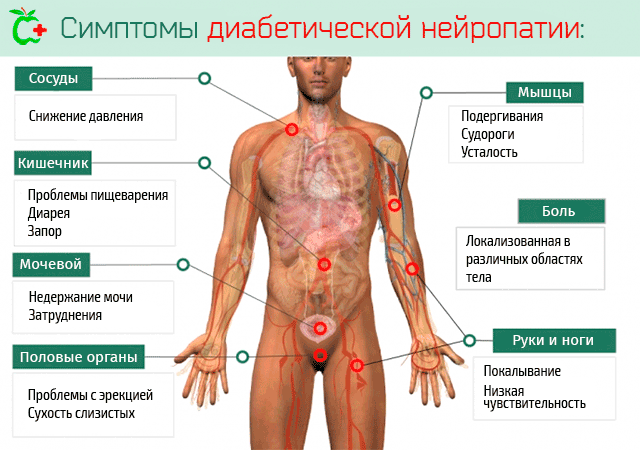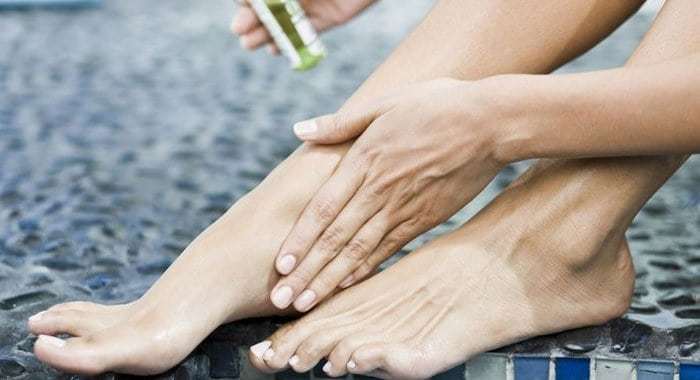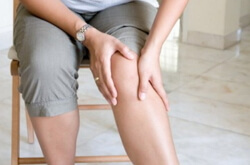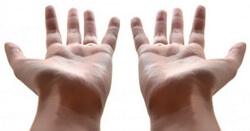Polyneuropathy of the upper and lower extremities: symptoms and treatment
Polyneuropathy of the upper and lower extremities is a pathology in the work of peripheral nerve endings. Basically, the disease affects the nervous system of the upper and lower extremities.
The disease manifests itself in loss of sensitivity, dysfunction, decreased muscle performance.
Basically, pathologies are atrophic in nature, bring a lot of suffering. More often, the foci of the disease spread precisely in the lower extremities. As a rule, the disease spreads from the bottom up. This is due to the fact that the long nerve fibers are affected first.
Content
- Polyneuropathy of the extremities of various types (classification of the disease)
- Causes of extremity polyneuropathy
- Symptoms and manifestations of the disease
- Diagnosis of the disease
- Treatment of polyneuropathy of the upper and lower extremities
- Complication after polyneuropathy and prognosis for cure
- Disease prevention
- Traditional methods of prevention and treatment of polyneuropathy
Polyneuropathy of the extremities of various types (classification of the disease)
Polyneuropathy is divided into 4 main types according to the localization of the lesion and the effect on certain fibers and their structures.

Polyneuropathy of the type of affected fibers. In the human body, fibers are divided among themselves according to their functionality. The disease that affects each group has its own symptoms and signs. Thus, according to their defeat, the disease can be divided into:
- a type of disease that affects motor nerve fibers. This species is distinguished by such characteristic features as decreased muscle performance, frequent convulsions, failure of muscle fiber sensitivity, to complete atrophy;
- a type of disease affecting sensory fibers. Nerve fibers responsible for sensitivity and sensory perception;
- a type of disease that affects vegetative fibers. This species is characterized by a violation of the blood flow system, profuse sweating, impotence and diseases of the genitourinary system;
- mixed type, due to damage to all types of nerve fibers;
The structure of nerve fibers consists of axons and myelin sheaths. Polyneuropathy can affect only a certain layer in the structure of the nerve fiber. Thus, by the nature of the damage to the fibers, the disease can be divided into:
- The disease that affects the layer of axons in the nerve fibers lasts for a long time and manifests itself in atrophy of the extremities. Since it affects to a greater extent the autonomic functions of the limbs;
- a disease that destroys the myelin sheaths develops much faster. Pathology manifests itself in a violation of sensory and motor functions;
By the localization of lesions, it is possible to determine such types as distal (the foci are located in the lower sections) and proximal (the foci are located in the upper sections).
It is possible to assess the type of polyneuropathy for various reasons for the onset of the disease:
- toxic polyneuropathy. The onset of the disease is provoked by poisoning with antibiotics or other toxic substances (salts, heavy metals, arsenic);
- dysmetabolic polyneuropathy. The nature of the occurrence comes from functional disorders in the nerve fibers. Which occur against the background of the penetration of the decay products of certain drugs into the blood. As a result, there is a violation of metabolic processes that lead to the disease;
- alcoholic polyneuropathy. The disease is provoked by the abuse of alcohol and its decay products;
- diabetic polyneuropathy. The disease occurs against the background of diabetes mellitus;
Read also:Chorea of Huntington: what is this disease, symptoms, videos of patients, causes and treatment of this disease
Causes of extremity polyneuropathy

Despite the fact that different types of polyneuropathy are due to different causes of occurrence, the main reasons for the development of pathology include:
- Impaired immune system. A special pathology of immunity manifests itself, in which immune cells devour each other, affecting immune nerve fibers;
- genetic abnormalities and other congenital factors, including hereditary;
- metabolic disease. For example, impaired blood sugar metabolism in diabetes mellitus, or impaired metabolism of protein products in the blood with uremia;
- poisoning with chemicals and their decay products;
- bacterial and viral infections, concomitant damage to the immune and nervous system in the body;
- various tumors;
- systemic diseases, expressed by disorders in connective tissues and blood vessels;
- avitaminosis;
- hormonal disorders in the work of the glands;
- diseases of the genitourinary system;
- liver and gallbladder disease;
Symptoms and manifestations of the disease

Polyneuropathy of the upper and lower extremities by symptomatology and manifestation, it can be divided into primary, when symptoms and lesions are sensitive character and a more severe secondary, which is due to disorders of the functioning of the nervous system limbs. Symptoms and signs expressing the disease:
- limb tremor. Can be persistent, intermittent and manifest under certain circumstances;
- cramps and spasms with painful sensations in the muscles of the upper and lower extremities;
- twitching. Which occur due to involuntary muscle contraction (fasciculation);
- goose bumps and a feeling of shivering on the skin;
- sharp jumps in blood pressure in the arteries. Such symptoms occur with damage to the nerve fibers responsible for the work of blood vessels and cardiac functions;
- a sharp increase in heart rate;
- decrease in the performance of muscle fibers. As a rule, weakness develops initially in the farthest muscles of the limbs, fingers and heels;
- decreased muscle tone;
- complete muscular atrophy;
- atrophy of the sensitivity of the skin;
- loss of orientation in space during sharp turns, rises, walking blindfolded and disruptions in the sense of balance;
- oxygen starvation of the brain. Consequently dark circles and flies before the eyes, dizziness, darkening in the eyes. Especially often, these signs appear with a sharp rise from a prone position;
- constant value of heart rate, pulse;
- dry skin;
- violation of the gastrointestinal tract, in the form of constipation;
- swelling of the legs;
- a feeling of stitching pains;
Diagnosis of the disease
At the first sign of illness, you need to see a doctor immediately. Your doctor will assess your general condition and, if necessary, prescribe a diagnosis to determine polyneuropathy of the upper and lower extremities. Diagnostics of the definition of the disease consists in:
- the study of the patient's complaints and his existing diseases in the anamnesis;
- consideration of the fact of taking alcohol in exorbitant quantities. Alcohol abuse;
- interrogation of the patient, with the establishment of his place of work and the exclusion of contact with chemicals;
- the presence of diseases in the patient, manifested in changes in the metabolism of sugar and protein products in the blood;
- hereditary factor. Does the patient have relatives with such a disease;
- general blood analysis;
- blood test for glucose and protein products;
- a blood test for toxic substances;
- biopsy of nerve fibers;
- electroneuromyography. Diagnostics of the depth of damage to the nerve fiber;
- consultation of narrow specialists in the direction of endocrinology and therapy;
- ultrasound diagnostics of internal organs;
- X-ray examination;
- analysis of cerebrospinal material;
- research of reflexes;
- checking the speed of nervous reactions;
- identification of concomitant somatic symptoms;
- palpation of the nerve trunks;
- additional methods at the discretion of the doctor;
Read also:Charcot-Marie-Tooth disease (CMT)
After a complete diagnosis, the doctor determines the degree and nature of polyneuropathy. Based on these data, adequate treatment is prescribed.
Treatment of polyneuropathy of the upper and lower extremities
Treatment of a disease affecting the nervous system of fibers is a complex process. Includes several types of treatment and procedures. The first step on the road to recovery is to identify the main primary diseases, the consequence of which is polyneuropathy. The whole complex of primary procedures and courses should be aimed at eliminating the primary causes of the disease. In order to exclude its further repetition.

Drug therapy is prescribed taking into account the course of the disease and consists in taking the following drugs:
- methylprednisolone. Glucocorticoid drug;
- analgin and tramadol, to relieve severe pain;
- drugs that suppress immune processes;
- potassium salts, vitamin b, vitamin C;
- protein diet;
- antihistamines (tavegil, suprastin, zodak);
- drugs that improve blood circulation;
- drugs that improve muscle-nervous permeability (proserin);
- mildronate and piracetam. To improve the nutrition of nerve fibers;
- the use of drugs that purify the blood for alcoholic and toxic polyneuropathy;
- antidepressants in the treatment of pain syndrome;
- fast sodium channel blockers for pain relief;
- anesthesia with gabapentin courses;
- anticonvulsants;
In addition to drug therapy, physiotherapy procedures are widely used in courses aimed at treating polyneuropathy. Physical procedures are usually used to consolidate the results of treatment or in its residual stages. Physiotherapy methods used in the courses:
- massotherapy;
- magnetic effect on the periphery of nerve fibers;
- the use of electrical appliances for direct stimulation of nerve fibers;
- indirect massage of internal organs;
To maintain the tone of muscle fibers and support their performance, the patient is assigned constant therapeutic exercises. with a special course of procedures. The doctor calculates the necessary physical activity and the necessary set of exercises.
Self-medication and diagnosis of such a disease is an extremely dangerous occupation. All complexes must be prescribed by a doctor and carried out under his supervision.
Complication after polyneuropathy and prognosis for cure
Polyneuropathy, like all diseases of the nervous system, entails consequences. The most common is the complete loss of the ability to move independently. This outcome is due to the neglect of various forms of the disease, which led to complete atrophy of muscle fibers in the limbs. And their complete weakening. In no case should polyneuropathy be ignored and the start of the treatment course should be delayed.
Read also:Duchenne muscular dystrophy
A complete cure for the disease is possible only at the beginning of the treatment process in the initial stage of the disease. After the disease develops into a chronic form, the cure ceases to be real. However, with proper adherence to the doctor's recommendations, you can practically get rid of the manifestation of polyneuropathy. With proper treatment, it is possible to completely slow down the spread of lesions of nerve fibers in the extremities.
Disease prevention

The disease polyneuropathy is a rather serious disease that everyone would like to avoid if possible. In order for a neurological ailment not to touch you, you need to follow and adhere to a number of simple rules:
- exclude the use of alcoholic and low-alcohol drinks;
- when interacting with and coming into contact with chemicals, use protective equipment and take cleansing preparations;
- eating natural products. Avoid eating foods with a high risk of chemical poisoning;
- do not take self-prescribed antibiotics and other drugs. Take medication only according to the strict prescription of a doctor;
- timely start treatment of viral and bacterial infections. Prevent neglected diseases and consequences;
- take seasonal vitamin courses that strengthen the immune system;
At the first, even several, signs of polyneuropathy, immediately consult a doctor for diagnosis and adequate treatment. By timely treatment, you will shorten the rehabilitation period and have every chance to stop the disease.
Traditional methods of prevention and treatment of polyneuropathy
Infusion treatment: chopped red clover flowers (pre-dried), garlic powder, poop, chop dry black cohosh, sage, yellow root and cassia bark. Pour tablespoons of the chopped mixture with 600 ml of boiling water and leave in a thermos for about 4 hours or more. Take 100 ml 3 times a day.
Dry leaves of ginkgo biloba 4 tbsp. l. pour 1 liter. boiling water. Insist 4 days. Take instead of tea.
Oil treatment: fill a 0.5 liter jar with crushed St. John's wort. Fill with warm vegetable oil. we insist the mixture for 20 days in a dark, warm place. After cooking, filter and add grated ginger about 1 tbsp. spoons. We use oil for massages and wraps.
Milk thistle seeds 4 tbsp l. grind in a mortar and add 150g of olive oil at about 60C. Add 2 tbsp. l. dry mint. Take 2 tbsp. l. half an hour before meals three times a day. The course of treatment is 20 days.
It should be remembered that all alternative methods are effective only in combination with adequate therapy prescribed by your doctor. Before starting any course, you should discuss this treatment with your doctor. Self-medication is dangerous!



